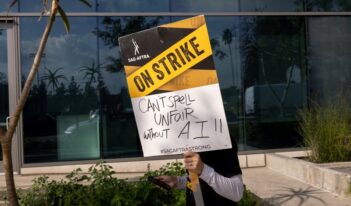
Scholars recommend ways for regulators level the playing field by empowering workers.
One in eight Americans. That is how many Americans have the shared experience of having worked at McDonald’s.
An even greater American commonality is the shared experience of working a low wage job as one study estimates 44% of workers in America earn a low hourly wage. As a result, many Americans intimately know the struggles that many workers confront, such as low wages and poor working conditions.
In a recent article, Hiba Hafiz and Ioana Marinescu argue that workers’ power to negotiate for better conditions and wages has eroded in recent years. They point to a variety of factors, including insufficient regulation and anticompetitive conduct from employers, as some of the reasons for this decline in power. Yet, they also view it as fortunate that the Biden Administration has acknowledged the issue and taken steps to remedy it.
For instance, President Biden has stated that the decline of workers’ power requires a “whole-of-government” approach. Hafiz and Marinescu, in turn, acknowledge that a whole-of-government approach may need cooperation between federal agencies, and the two outlined a regulatory framework to facilitate this cooperation.
Hafiz and Marinescu argue that workers’ power comes from their voice and exit options. Workers’ voice describes their ability to improve their current employment relationship by negotiating better conditions. Hafiz and Marinescu describe exit options as workers’ alternatives to their current jobs, including moving to another company or being without a job. Workers exit options influence their wages and conditions because they can use alternatives as negotiating leverage to improve their current job or leave and reap the benefits of their alternatives.
Hafiz and Marinescu note that a worker’s voice can typically be amplified through collective bargaining, such as a union. Bargaining through labor unions may create a “union wage premium” of 15 to 25 percent higher wages.
Similarly, workers’ exit options can be influenced by skill levels, labor supply, and the availability of other companies or jobs—which in turn can depend on a range of factors including employers’ conduct and regulations. Hafiz and Marinescu argue that employers’ conduct, such as establishing barriers to unionizing and limiting exit opportunities through restrictive non-compete agreements, have exacerbated the power imbalance.
How can employers’ practices that seek to squelch workers’ power be resisted? Hafiz and Marinescu point to the role for collaboration between federal labor agencies and federal antitrust agencies.
The National Labor Relations Board (NLRB), which is tasked with safeguarding the statutory rights of workers to unionize and collectively bargain, makes decisions about which workers are employees—and can unionize—and which are independent contractors—and can not.
Another important labor agency—the Department of Labor—can improve workers’ power by influencing workers’ exit options, argue Hafiz and Marinescu. For instance, they say that the Department can establish wage floors through minimum wages, maximum hour restrictions, and overtime regulations, which can provide a minimum level of power for workers.
Some economists argue, however, that efforts to regulate workers’ pay and other conditions only hurt workers by reducing the number of employment opportunities. Hafiz and Marinescu respond by stating negative outcomes are predicated on assumptions that the employment markets are “perfect”—that is, the markets operate the way economists treat them in theory. Moreover, Hafiz and Marinescu contend that regulations such as minimum wages are beneficial in “imperfect” markets. They cite evidence of imperfections such as search costs—the expense and difficulty people have in finding alternative employment.
At the same time that labor agencies can help workers who face these market imperfections, another set of agencies can stifle workers’ voices by hindering collective bargaining, argue Hafiz and Marinescu. Antitrust agencies, for example, have charged unprotected workers who are deemed to be independent contractors with unlawfully colluding when they try to organize.
Yet Hafiz and Marinescu are quick to note that antitrust agencies can also benefit workers’ power, as their investigations and enforcement activities collect data that can be used to assess workers’ voice. Moreover, these agencies can positively influence worker exit opportunities by restricting anticompetitive practices that reduce available open job alternatives.
Hafiz and Marinescu propose a series of regulatory reforms by antitrust and labor agencies to protect workers’ power. They favor using a “regulatory checklist” that summarizes the market indicators of worker power —such as union membership and the number of job vacancies for workers—and a list of agencies and private institutions that compile the data. These data may help agencies decide which industries and companies to target for regulatory enforcement. Hafiz and Marinescu suggest that, to maximize regulatory impact, agencies should prioritize their policies.
For example, they propose revisiting previous rulings from the NLRB, such as allowing employers to require employees to attend anti-union meetings, as new empirical evidence has shown that these decisions have been contrary to the organization’s stated mission of protecting the right to unionize.
Hafiz and Marinescu also recommend that agencies share their enforcement data with one another. Agencies such as the NLRB can provide antitrust agencies with a clearer understanding of a market and the potential impacts of a merger on labor unions. Similarly, antitrust agencies can provide the NLRB with data that would help the NLRB make more informed decisions in classifying workers as employees or independent contractors, thus impacting those employees’ right to unionize.
Some regulatory critics might argue that such measures could be avoided by establishing private rights of action, but Hafiz and Marinescu explain that private individuals lack the knowledge to spot power issues. They argue that agencies are needed to step in to help workers be able to organize.
Hafiz and Marinescu raise concerns, however, that agencies will lack the resources needed to collaborate in ways that help empower workers. They note that budget cuts have hindered labor and antitrust agencies while the number of workers and employers they oversee has only increased.
Even in an era of shrinking governmental budgets, Hafiz and Marinescu emphasize the importance of government agencies pursuing efficiency-improving policies to empower workers.



